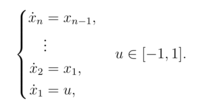SURF 2019: Geometry of Control-Invariant Sets: Difference between revisions
No edit summary |
mNo edit summary |
||
| (One intermediate revision by the same user not shown) | |||
| Line 1: | Line 1: | ||
'''[[SURF 2019|2019 SURF]]: project description''' | |||
* Mentor: Richard M. Murray | |||
* Co-mentor: Petter Nilsson | |||
The concept of a ''control-invariant'' set---a set <math>X</math> with the property that a controller can make the state <math>x(t)</math> of a system remain inside of <math>X</math> for all positive <math>t</math> ---is closely connected with safety and reliability of engineered systems [1]. Invariant sets can be used to construct controllers that make systems such as quadrotors avoid crashes [2]. Unfortunately, analytical expressions for control-invariant sets are not known for many important systems, and are also hard to compute numerically in high dimensions. | The concept of a ''control-invariant'' set---a set <math>X</math> with the property that a controller can make the state <math>x(t)</math> of a system remain inside of <math>X</math> for all positive <math>t</math> ---is closely connected with safety and reliability of engineered systems [1]. Invariant sets can be used to construct controllers that make systems such as quadrotors avoid crashes [2]. Unfortunately, analytical expressions for control-invariant sets are not known for many important systems, and are also hard to compute numerically in high dimensions. | ||
| Line 7: | Line 11: | ||
[[File:N_integrator.png|200px]] | [[File:N_integrator.png|200px]] | ||
For <math>n</math> = 2 a closed-form expression of the maximal control-invariant set contained inside the unit hypercube is known [3. eq. (53)], but for higher orders of <math>n</math> only numerical approaches are currently available. The figures above show numerical approximations for <math>n</math> equal to 2 and <math>n</math> equal to 3. | For <math>n</math> = 2 a closed-form expression of the maximal control-invariant set contained inside the unit hypercube is known [3. eq. (53)], but for higher orders of <math>n</math> only numerical approaches are currently available. The figures above show numerical approximations for <math>n</math> equal to 2 and <math>n</math> equal to 3. | ||
The objective of this project is to investigate geometrical properties of control-invariant sets via a combination of analytical and numerical techniques. In particular, | |||
* Search for closed-form expressions or cheap-to-evaluate algorithms that characterize control-invariant sets for n > 2. | * Search for closed-form expressions or cheap-to-evaluate algorithms that characterize control-invariant sets for n > 2. | ||
* Investigate incremental algorithms, i.e., if the set for n is known, can we characterize the set for n+1? | * Investigate incremental algorithms, i.e., if the set for n is known, can we characterize the set for n+1? | ||
| Line 14: | Line 19: | ||
Familiarity with the following topics is desirable: | Familiarity with the following topics is desirable: | ||
* Advanced knowledge of linear ordinary differential equations. | * Advanced knowledge of linear ordinary differential equations. | ||
* Optimization. | * Optimization. | ||
Latest revision as of 03:40, 28 November 2018
2019 SURF: project description
- Mentor: Richard M. Murray
- Co-mentor: Petter Nilsson
The concept of a control-invariant set---a set with the property that a controller can make the state of a system remain inside of for all positive ---is closely connected with safety and reliability of engineered systems [1]. Invariant sets can be used to construct controllers that make systems such as quadrotors avoid crashes [2]. Unfortunately, analytical expressions for control-invariant sets are not known for many important systems, and are also hard to compute numerically in high dimensions.
Some of the most fundamental dynamical systems are linear -order integrators:
For = 2 a closed-form expression of the maximal control-invariant set contained inside the unit hypercube is known [3. eq. (53)], but for higher orders of only numerical approaches are currently available. The figures above show numerical approximations for equal to 2 and equal to 3.
The objective of this project is to investigate geometrical properties of control-invariant sets via a combination of analytical and numerical techniques. In particular,
- Search for closed-form expressions or cheap-to-evaluate algorithms that characterize control-invariant sets for n > 2.
- Investigate incremental algorithms, i.e., if the set for n is known, can we characterize the set for n+1?
- Stretch goal: generalize the incremental ideas to differential extensions of general systems such as the quadrotor dynamics on SE(3).
Familiarity with the following topics is desirable:
- Advanced knowledge of linear ordinary differential equations.
- Optimization.
- Programming in Matlab and/or Python (the figures above were created with code from https://github.com/pettni/pcis).
References
[1] Blanchini, F. (1999). Set invariance in control. Automatica, 35(11), 1747–1767. https://doi.org/10.1016/S0005-1098(99)00113-2
[2] https://www.youtube.com/watch?v=rK9oyqccMJw
[3] Ames, A. D., Xu, X., Grizzle, J. W., & Tabuada, P. (2017). Control Barrier Function Based Quadratic Programs for Safety Critical Systems. IEEE Transactions on Automatic Control, 62(8), 3861–3876. https://doi.org/10.1109/TAC.2016.2638961






